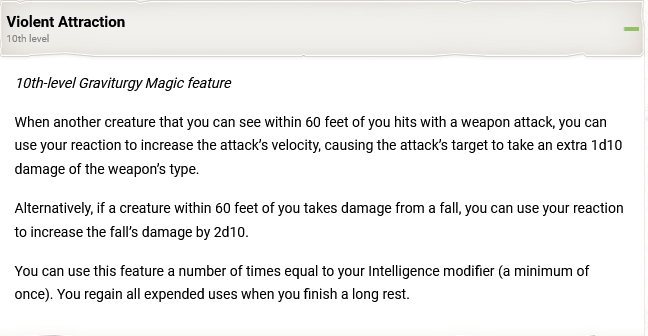I sent a tweet to Crawford and Mercer to hopefully get a more official ruling as I couldn't find anything on twitter or here.
But on the Graviturgist's "Violent Attraction" feature. As it is a rolled damage granted to the attacker (same as sneak attack, which applies), does crit rules apply and roll double if the wizard used their reaction to grant the extra damage on a crit that he sees within range?
And the feature for any that might not have access:
The wording of the feature suggests no. “You can cause the target to take an extra 1d10 damage” is not “you cause the attack to deal an extra 1d10 damage.” This bonus damage is done by the feature and by the graviturgist, not by the attack that scored a crit.
Additionally, the trigger is a hit, not an attack, so the damage isn’t added until the crit has already happened, so conceptually there’s not an easy way to see it benefitting from the crit.
The wording makes it feel pretty clear that they meant what they said: the attack deals its own damage (double dice if a crit), and then, on top of that, the feature adds 1d10.
Rollback Post to RevisionRollBack
To post a comment, please login or register a new account.
I sent a tweet to Crawford and Mercer to hopefully get a more official ruling as I couldn't find anything on twitter or here.

But on the Graviturgist's "Violent Attraction" feature. As it is a rolled damage granted to the attacker (same as sneak attack, which applies), does crit rules apply and roll double if the wizard used their reaction to grant the extra damage on a crit that he sees within range?
And the feature for any that might not have access:
The wording of the feature suggests no. “You can cause the target to take an extra 1d10 damage” is not “you cause the attack to deal an extra 1d10 damage.” This bonus damage is done by the feature and by the graviturgist, not by the attack that scored a crit.
Additionally, the trigger is a hit, not an attack, so the damage isn’t added until the crit has already happened, so conceptually there’s not an easy way to see it benefitting from the crit.
The wording makes it feel pretty clear that they meant what they said: the attack deals its own damage (double dice if a crit), and then, on top of that, the feature adds 1d10.